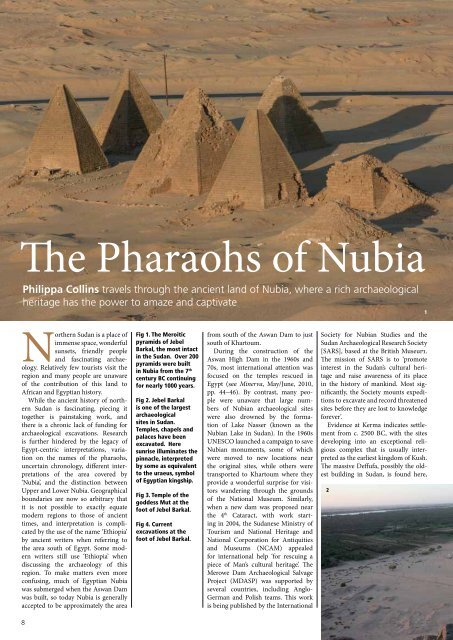Cult of beauty - Minerva
Cult of beauty - Minerva
Cult of beauty - Minerva
Create successful ePaper yourself
Turn your PDF publications into a flip-book with our unique Google optimized e-Paper software.
The Pharaohs <strong>of</strong> Nubia<br />
Philippa Collins travels through the ancient land <strong>of</strong> Nubia, where a rich archaeological<br />
heritage has the power to amaze and captivate<br />
Northern Sudan is a place <strong>of</strong><br />
immense space, wonderful<br />
sunsets, friendly people<br />
and fascinating archaeology.<br />
Relatively few tourists visit the<br />
region and many people are unaware<br />
<strong>of</strong> the contribution <strong>of</strong> this land to<br />
African and Egyptian history.<br />
While the ancient history <strong>of</strong> northern<br />
Sudan is fascinating, piecing it<br />
together is painstaking work, and<br />
there is a chronic lack <strong>of</strong> funding for<br />
archaeological excavations. Research<br />
is further hindered by the legacy <strong>of</strong><br />
Egypt-centric interpretations, variation<br />
on the names <strong>of</strong> the pharaohs,<br />
uncertain chronology, different interpretations<br />
<strong>of</strong> the area covered by<br />
‘Nubia’, and the distinction between<br />
Upper and Lower Nubia. Geographical<br />
boundaries are now so arbitrary that<br />
it is not possible to exactly equate<br />
modern regions to those <strong>of</strong> ancient<br />
times, and interpretation is complicated<br />
by the use <strong>of</strong> the name ‘Ethiopia’<br />
by ancient writers when referring to<br />
the area south <strong>of</strong> Egypt. Some modern<br />
writers still use ‘Ethiopia’ when<br />
discussing the archaeology <strong>of</strong> this<br />
region. To make matters even more<br />
confusing, much <strong>of</strong> Egyptian Nubia<br />
was submerged when the Aswan Dam<br />
was built, so today Nubia is generally<br />
accepted to be approximately the area<br />
8<br />
Fig 1. The Meroitic<br />
pyramids <strong>of</strong> Jebel<br />
Barkal, the most intact<br />
in the Sudan. Over 200<br />
pyramids were built<br />
in Nubia from the 7 th<br />
century BC continuing<br />
for nearly 1000 years.<br />
Fig 2. Jebel Barkal<br />
is one <strong>of</strong> the largest<br />
archaeological<br />
sites in Sudan.<br />
Temples, chapels and<br />
palaces have been<br />
excavated. Here<br />
sunrise illuminates the<br />
pinnacle, interpreted<br />
by some as equivalent<br />
to the uraeus, symbol<br />
<strong>of</strong> Egyptian kingship.<br />
Fig 3. Temple <strong>of</strong> the<br />
goddess Mut at the<br />
foot <strong>of</strong> Jebel Barkal.<br />
Fig 4. Current<br />
excavations at the<br />
foot <strong>of</strong> Jebel Barkal.<br />
from south <strong>of</strong> the Aswan Dam to just<br />
south <strong>of</strong> Khartoum.<br />
During the construction <strong>of</strong> the<br />
Aswan High Dam in the 1960s and<br />
70s, most international attention was<br />
focused on the temples rescued in<br />
Egypt (see <strong>Minerva</strong>, May/June, 2010,<br />
pp. 44–46). By contrast, many people<br />
were unaware that large numbers<br />
<strong>of</strong> Nubian archaeological sites<br />
were also drowned by the formation<br />
<strong>of</strong> Lake Nasser (known as the<br />
Nubian Lake in Sudan). In the 1960s<br />
UNESCO launched a campaign to save<br />
Nubian monuments, some <strong>of</strong> which<br />
were moved to new locations near<br />
the original sites, while others were<br />
transported to Khartoum where they<br />
provide a wonderful surprise for visitors<br />
wandering through the grounds<br />
<strong>of</strong> the National Museum. Similarly,<br />
when a new dam was proposed near<br />
the 4 th Cataract, with work starting<br />
in 2004, the Sudanese Ministry <strong>of</strong><br />
Tourism and National Heritage and<br />
National Corporation for Antiquities<br />
and Museums (NCAM) appealed<br />
for international help ‘for rescuing a<br />
piece <strong>of</strong> Man’s cultural heritage’. The<br />
Merowe Dam Archaeological Salvage<br />
Project (MDASP) was supported by<br />
several countries, including Anglo-<br />
German and Polish teams. This work<br />
is being published by the International<br />
Society for Nubian Studies and the<br />
Sudan Archaeological Research Society<br />
[SARS], based at the British Museum. f<br />
The mission <strong>of</strong> SARS is to ‘promote<br />
interest in the Sudan’s cultural heritage<br />
and raise awareness <strong>of</strong> its place<br />
in the history <strong>of</strong> mankind. Most significantly,<br />
the Society mounts expeditions<br />
to excavate and record threatened<br />
sites before they are lost to knowledge<br />
forever’.<br />
Evidence at Kerma indicates settlement<br />
from c. 2500 BC, with the sites<br />
developing into an exceptional religious<br />
complex that is usually interpreted<br />
as the earliest kingdom <strong>of</strong> Kush.<br />
The massive Deffufa, possibly the oldest<br />
building in Sudan, is found here,<br />
2<br />
1

















